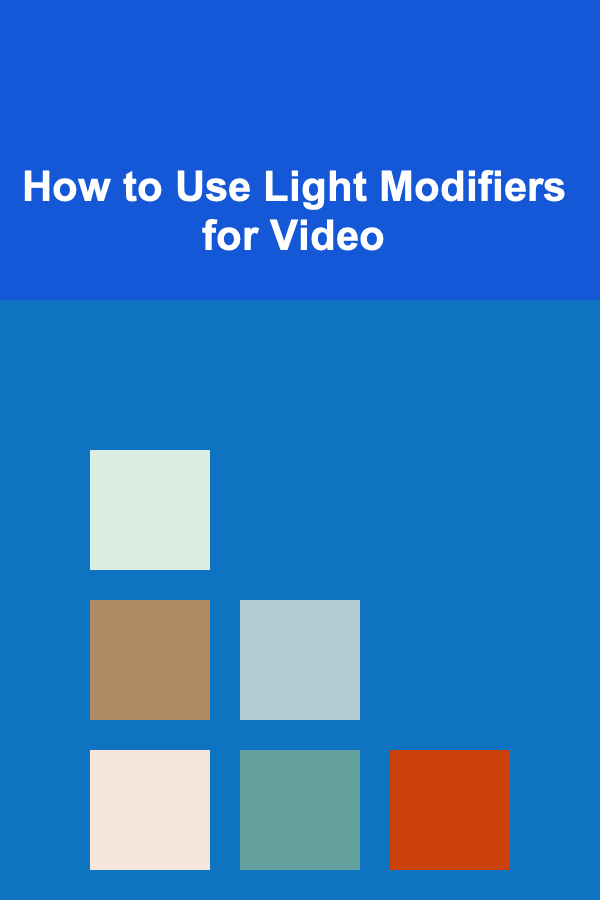
How to Use Light Modifiers for Video
ebook include PDF & Audio bundle (Micro Guide)
$12.99$8.99
Limited Time Offer! Order within the next:

Lighting is one of the most crucial aspects of video production, impacting everything from the mood and tone to the overall aesthetic of the content. However, lighting by itself is not always enough. This is where light modifiers come into play. Light modifiers can drastically alter the look and feel of your lighting, helping you shape your scene in a way that fits your vision.
In this article, we'll explore the different types of light modifiers used in video production, how they work, and how you can use them effectively to enhance your videos.
What Are Light Modifiers?
Light modifiers are tools used to control the intensity, direction, quality, and texture of light. They manipulate the light output from a light source to create specific effects or looks that would be difficult or impossible to achieve with the bare light alone.
Light modifiers can soften harsh light, direct light to specific areas, create diffused light for a natural look, or generate sharp, focused beams. The type of light modifier you choose will depend on your creative vision, the type of video you're shooting, and the overall look you want to achieve.
Key Functions of Light Modifiers:
- Soften the Light: Softening the light reduces shadows and creates a more flattering, even illumination.
- Control the Direction: Directing light allows you to focus on specific areas or subjects within the frame.
- Adjust the Intensity: Light modifiers can help you control the brightness of the light and prevent overexposure.
- Shape the Light: Some modifiers can shape the light to create different patterns and effects.
Understanding how to effectively use light modifiers is a key skill for any video creator. Below, we'll delve into the most common light modifiers and how they're used in video production.
Types of Light Modifiers
1. Softboxes
Softboxes are perhaps the most popular light modifier used in both photography and video production. A softbox is essentially a light enclosure that diffuses the light source, softening the harshness of the beam.
How They Work: A softbox surrounds the light source with reflective surfaces and a fabric diffuser. The light is bounced around within the softbox and exits through the diffuser, creating soft, even illumination that is much less harsh than a direct light.
When to Use: Softboxes are ideal when you need to soften the light for beauty shots, interviews, or product videos. They reduce harsh shadows, creating a flattering, even lighting effect that is very popular for portrait work.
Key Benefits:
- Softens light for a more flattering look
- Minimizes harsh shadows
- Versatile for various shooting scenarios
2. Umbrellas
Umbrellas, like softboxes, diffuse light to soften it, but they work a little differently. An umbrella consists of a reflective fabric or material that surrounds the light source. The light is either bounced off the reflective surface or passes through the translucent fabric of the umbrella.
How They Work: There are two types of umbrellas: reflective and shoot-through. A reflective umbrella bounces the light back at the subject, while a shoot-through umbrella allows the light to pass through it, creating a softer effect.
When to Use: Umbrellas are often used when you need a large, soft light source but don't have the space for a big softbox. They're particularly good for wide shots or lighting groups of people.
Key Benefits:
- Quick setup
- Larger coverage area compared to softboxes
- Creates a softer light with less harsh shadows
3. Diffusers
Diffusers are materials that soften the light by scattering it. They come in various shapes and sizes, and they can be used to modify both natural and artificial light sources.
How They Work: A diffuser works by reducing the intensity of the light and spreading it over a wider area, softening the overall effect. The most common diffusers are made from semi-opaque fabrics or plastic materials.
When to Use: Diffusers are commonly used in outdoor shooting to soften harsh sunlight or to create softer lighting effects indoors. They're perfect for controlling the sharpness of shadows and creating a more natural look.
Key Benefits:
- Can be used in various lighting setups, indoors and outdoors
- Reduces harsh shadows
- Can be used to modify both natural and artificial light sources
4. Grids (Honeycomb Grids)
A grid or honeycomb grid is a light modifier that limits the spread of light. It consists of a mesh of small cells that focus and direct the light in a specific direction, allowing for more precise control.
How They Work: Honeycomb grids attach to the front of softboxes or other light sources. The grid controls the direction of the light, narrowing its spread and preventing it from spilling into unwanted areas of the frame.
When to Use: Grids are useful when you want to create dramatic lighting or focus on a specific part of the scene. They're often used in product photography, fashion shoots, and for creating cinematic lighting effects.
Key Benefits:
- Allows precise control of light direction
- Reduces spill light, focusing the light on specific areas
- Great for dramatic or moody lighting setups
5. Flags
Flags are used to block, shape, or control the direction of light. They are typically large black panels that can be placed between the light source and the subject to block out unwanted light or to create shadows.
How They Work: Flags are placed between the light source and the subject to either block the light completely or shape it by casting shadows on specific areas.
When to Use: Flags are useful when you need to control the intensity and location of the light. They're commonly used in film and TV production to create shadows or control the contrast in a scene.
Key Benefits:
- Helps control light spill
- Can create shadows for dramatic effects
- Offers precise control over light placement
6. Bounce Boards (Reflectors)
Bounce boards, also known as reflectors, are used to reflect light back onto the subject. They can be used to either bounce natural light (such as sunlight) or artificial light (from a lamp or other lighting source).
How They Work: A reflector is positioned to catch the light from a light source and redirect it toward the subject. Reflectors can be made from various materials, including white, silver, gold, or black surfaces, each providing different effects on the light.
When to Use: Reflectors are perfect for filling in shadows without adding more direct light. They're commonly used in outdoor settings or when you want to soften and reflect light back onto the subject for a more even exposure.
Key Benefits:
- Inexpensive and portable
- Softens or adds light to the subject without needing additional light sources
- Available in various colors for different effects
7. Barn Doors
Barn doors are adjustable flaps attached to the front of a light source to control the spread of the light. By adjusting the doors, you can direct light exactly where you need it.
How They Work: Barn doors allow you to adjust the intensity and direction of the light by opening or closing the flaps. This is especially useful for lighting specific areas of a scene or creating dramatic lighting effects.
When to Use: Barn doors are perfect for creating hard, focused light or for isolating a particular area of your frame. They are often used in combination with hard light sources like spotlights or fresnel lights.
Key Benefits:
- Precise control over light direction and spread
- Useful for creating hard light effects
- Can isolate specific areas in the frame
8. Scrims
A scrim is a semi-transparent material that diffuses light to soften its intensity. Scrims are often used in film production to reduce the harshness of direct sunlight or artificial lighting.
How They Work: A scrim is usually placed between the light source and the subject, diffusing the light to create a more natural look. It can be made from fabric or other materials that allow light to pass through while softening it.
When to Use: Scrims are great for outdoor shoots when you need to diffuse harsh sunlight or create a softer effect. They're also used in studio lighting to diffuse artificial light sources.
Key Benefits:
- Softens light and reduces intensity
- Creates a more natural, flattering look
- Portable and easy to set up
Practical Tips for Using Light Modifiers in Video
1. Understand Your Lighting Goal
Before selecting a light modifier, it's crucial to understand the kind of lighting effect you want to achieve. Are you aiming for soft, diffused light for an interview, or do you want dramatic, high-contrast lighting for a cinematic scene? Understanding your goal will help you choose the right modifier.
2. Experiment with Different Modifiers
Don't be afraid to experiment with different modifiers to see what works best for your specific scene. Mix and match softboxes, umbrellas, and grids to see how they impact the look and feel of your video. Sometimes, combining modifiers can give you a unique lighting effect.
3. Use Reflectors to Fill Shadows
Reflectors are a great way to fill in shadows without adding additional light. By bouncing light back into shadowed areas, you can create a more even, natural look.
4. Control Spill Light with Flags and Grids
If you're working in a tight space or need to control the spill of light, flags and grids are excellent tools for limiting the spread of light. They can be used to focus light exactly where it's needed and reduce unwanted illumination in the background or other areas.
5. Use the Right Light Modifier for the Scene
Always choose your light modifier based on the scene you're shooting. A softbox might be perfect for a beauty shot or portrait, but for a moody, dramatic film scene, a grid or barn doors may be a better choice to control the light.
6. Consider the Size and Shape of the Modifier
The size of your light modifier will influence how soft or hard the light is. Larger modifiers create softer light, while smaller modifiers produce more focused, harder light. Choose the size based on the subject and the look you're going for.
7. Balance the Light with Practical Effects
Light modifiers are just one part of the equation. For the best results, always consider how light interacts with the environment, subject, and camera angles. Use practical effects like candles, lamps, or other light sources to add depth and atmosphere to your scene.
Conclusion
Mastering light modifiers is essential for achieving professional-quality video lighting. Whether you need to soften your light, create sharp contrasts, or direct light exactly where it's needed, the right light modifier can completely transform the look of your video. By understanding the different types of modifiers and how they work, you can elevate your lighting setup and bring your creative vision to life.

How to Build a Content Promotion Checklist for Content Partnerships
Read More
How to Choose the Right Market Research Tools for Your Business
Read More
How to Sell Your Old Vinyl Records on eBay: A Comprehensive Actionable Guide
Read More
How to Set Up a DIY Photo Booth for Your Home Party
Read More
How to Tidy Up Your Home Quickly Before Guests Arrive
Read More
Top Tips for Comparing Internet Service Providers for Better Deals
Read MoreOther Products

How to Build a Content Promotion Checklist for Content Partnerships
Read More
How to Choose the Right Market Research Tools for Your Business
Read More
How to Sell Your Old Vinyl Records on eBay: A Comprehensive Actionable Guide
Read More
How to Set Up a DIY Photo Booth for Your Home Party
Read More
How to Tidy Up Your Home Quickly Before Guests Arrive
Read More